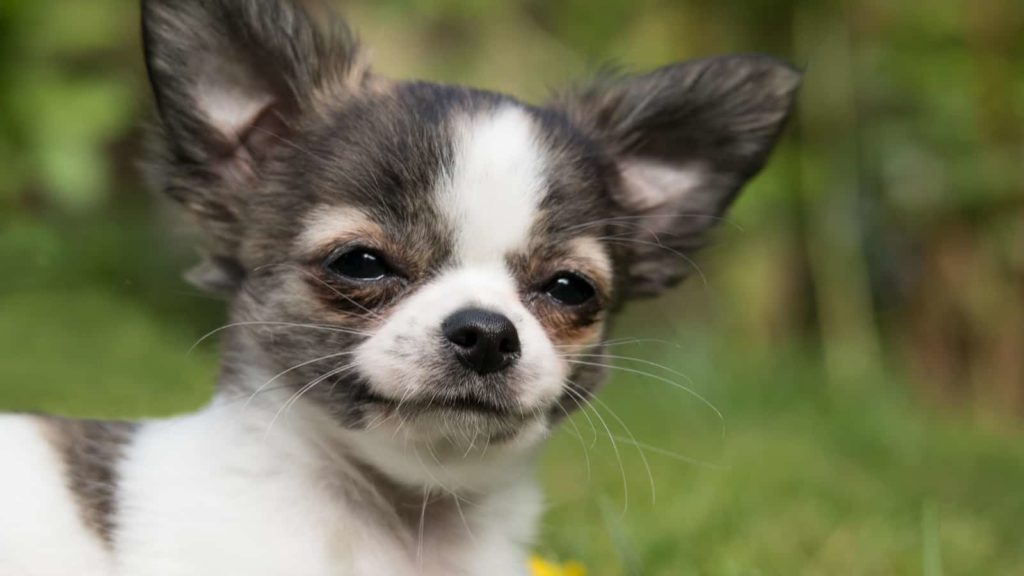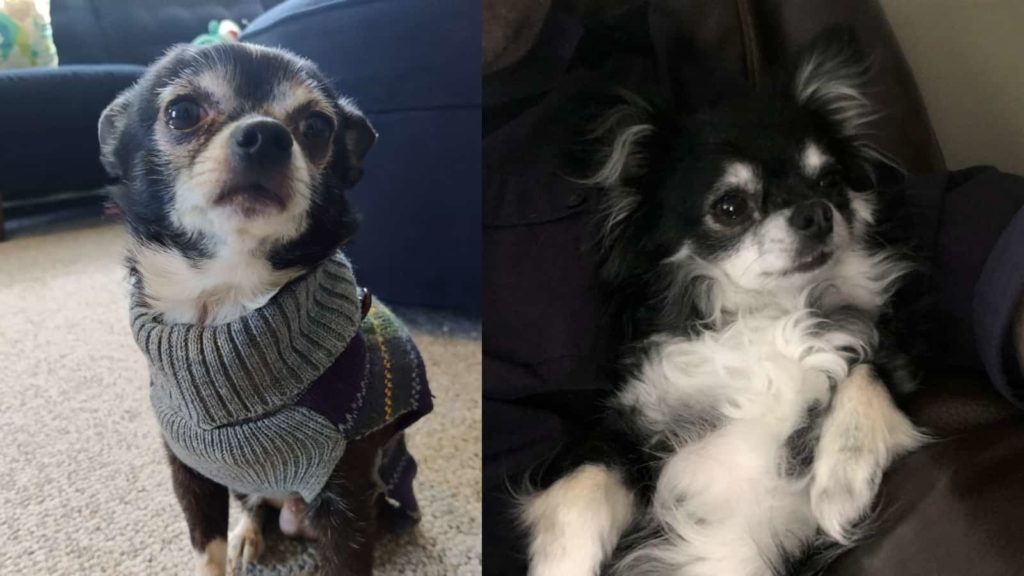Chihuahuas are some of the most adorable dogs around. They are known for their lively personalities and devotion to their owner. Seeing as they are known as one of the smallest dogs in the world, have you ever wondered how big their brains are?
All dog brains are around the same size no matter their breed. Chihuahuas are considered to have the “biggest brain” among all dogs because of their brain-to-body ratio. The ratio across all dog breeds is 1:125; but seeing as the Chihuahua is so tiny, their little bodies house a very large brain!

Average Brain Size For a Chihuahua
Since Chihuahuas are so tiny, people often wonder how big is the brain inside that tiny little head?
The Chihuahua’s brain is about the size of a tangerine. Picturing a tangerine compared to the size of a Chihuahua head makes the tangerine seem pretty big! Most dog brains weigh between 70–80 grams.
What Does a Chihuahua Brain Look Like?
The Chihuahua’s brain doesn’t have many folds, so it takes on the appearance of a more smooth surface.
Disclaimer: This post may contain affiliate links. We only recommend high-quality products that are used and recommended by real owners. If you use these links to buy something we earn a small commission.
Because there aren’t many folds in a Chihuahua’s brain like there are in a human’s brain, there is less opportunity for higher thinking; although, Chihuahuas are still able to perform with decent intelligence for a dog!
Can Chihuahuas Have Brain Disease?
Although there are more common issues that Chihuahuas develop such as eye diseases, allergies, bladder/kidney stones, etc.; Chihuahuas are often prone to neurological problems.
Several symptoms that can indicate neurological diseases in Chihuahuas include:
- Seizures
- Imbalance/Mobility issues
- Weakness
- Neck/Back Pain
- Strange Eye Movements
- Excessive Sleeping
- Confusion
These things are symptoms that may indicate a brain problem, but more often the cause is something else. Your vet is the best person to determine what is causing these symptoms in your dog.
Listed below are some possible brain diseases or brain problems that Chihuahuas might face.

Brain Tumors in Chihuahuas
Although rare Chihuahuas can have brain tumors. Older dogs are more susceptible to them as they age, unfortunately, there are starting to be cases when they are showing up in younger dogs. These tumors can be malignant or benign. Generally, the prognoses in a dog with a brain tumor is not good.
There has not been a lot of research conducted on brain tumors in dogs so it is hard to know how to advise a pet parent of what to do.
Here is a website that talks more about all the things that are known about brain tumors in dogs.
Hydrocephalus in Chihuahuas
Another brain condition to watch out for in Chihuahuas is something called Hydrocephalus (water on the brain). This means that there is spinal fluid leaking into their skulls and sitting on their brains. This causes their brains to swell which puts increased pressure on their skull and can be fatal.
Hydrocephalus is generally caused by a birth defect and can be found in puppies. It is more common in miniature and toy breeds such as Chihuahuas. It can be difficult to spot in puppies as one of the only signs is a large fontanel (soft spot) on their skull.
Sometimes having a large soft spot is enough to diagnose and treat hydrocephalus, but often CT scans or MRIs need to be done in order to make a definitive diagnosis.
Hydrocephalus in older Chihuahuas can also be caused by brain tumors. In this case, the expected outcome is often very grim.
Treatment for Hydrocephalus in puppies includes trying to reduce the pressure with the use of steroids, other medications, or possible placement of a neural tube. For older dogs who have brain tumors, it may be decided to do surgery or to just make the dog as comfortable as possible.
Brain Injuries & Brain Damage in Chihuahuas
Because Chihuahuas are so small and their brains so big compared to their body size they can be more susceptible to brain trauma. Getting hit by a car, falling from a large height, or being attacked by a larger animal are all things that could cause trauma to your Chihuahuas brain.
If any of these things happen to your Chihuahua please take them to your vet immediately. Your vet will be able to let you know the best course of action to help your Chihuahua recover. Here are some other helpful resources for you as well.
Pro Tip: If you are not able to get a hold of a vet near you, or you want to avoid an unnecessary ER trip, there are online resources that you can turn to. Here is our best recommendation:
Pawp: a 24/7 digital clinic for pets that connects you to an experienced vet
Why we love it:
🐾 Answers 24/7! 🐾 No waiting! 🐾 Get Answers Online with Local Vets! 🐾 Quick Response Time! 🐾 Easy Sign UP!
Try Pawp 7 Days For Free
Are Chihuahuas Smart or Stupid?
Although the Chihuahua’s brain is big in comparison to its body, the Chihuahua ranks an IQ at 125 out of 138 dog breeds; although they aren’t the smartest dogs around, this is considered sufficiently intelligent.
Because the variation in body size causes their brains to be much larger, they do benefit from their big brains! Chihuahuas have a great memory; they can learn a new command with just 40–80 repetitions, which seems pretty smart to me!
Read this article to learn more: How Smart are Chihuahuas (Not as Stupid as People Think!)
Although Chihuahuas lack some obedience towards learning from humans, they are highly intelligent in adapting to new environments that they are placed in.

Chihuahua Brain Development
Your chihuahua’s brain and emotional maturity are constantly growing and developing. From the time they are conceived to around one and a half when they reach their full emotional maturity, their brain is developing and learning new processes.
The first few months of life are the most crucial and rapid developmental period for your Chihuahua’s brain. This is why it is so important for them to be well socialized when they are young. By the time your dog is 20 weeks old, its brain is 80% developed.
Chihuahua Head Shape
Chihuahua owners sometimes associate their dog’s head shape with brain size; however, depending on a Chihuahua’s breed, they will have specific head structures and sizes that have nothing to do with their brain size.
There are many different breeds of Chihuahuas with different physical characteristics, these include:
- Short-hair Chihuahuas
- Long-hair Chihuahuas
- Apple head Chihuahuas
- Deer head Chihuahuas
- Teacup Chihuahuas
- Pear head chihuahuas
- Color-named Chihuahuas (fawn, chocolate, gray, etc.)
Two of the most commonly known head shapes are “apple” and “deer” heads. These terms are focused on the Chihuahua’s appearance, specifically the nose, mouth, and overall face structure.
Apple head Chihuahuas often have the appearance of a rounder-shaped head with a 90- degree angle where the nose meets the forehead; their eyes are sometimes more pronounced than other Chihuahuas. They are normally smaller than other Chihuahua breeds with a maximum weight of around 6 pounds.
Deer head Chihuahuas are generally larger than the apple-shaped Chihuahua. Normally deer head Chihuahuas are larger in body size as well, weighing up to 12 pounds. They have an overall slightly different appearance oftentimes including longer legs and longer necks.
Most teacup Chihuahuas have apple-shaped heads; however, teacup Chihuahuas with deer head structures do exist!
Most times it is very easy to tell whether a Chihuahua has an apple or deer head shape. Taking in the shape of the head as well as the body can normally help anyone determine quickly what type of Chihuahua they are looking at!
Chihuahua Brain to Body Ratio
The brain size of a Chihuahua is interesting in comparison to their standard body size which is normally between 5–8 inches in height. A Chihuahua’s weight is usually no more than 6 pounds unless the Chihuahua is oversized. Compared with humans and their 1:50 ratio, dogs are 1:125–a ratio that holds across all dog breeds.
Up Next: How Big Is a Chihuahuas Heart?
Can A Chihuahua Be A Service Dog? (How to Train Them)
While we strive to give the most accurate and helpful information about your pet’s health that we can, this article is meant to be informational only and not medical advice. Never disregard, avoid or delay in obtaining medical advice from your veterinarian or other qualified veterinary health care provider regardless of what you have read on this site or elsewhere.



